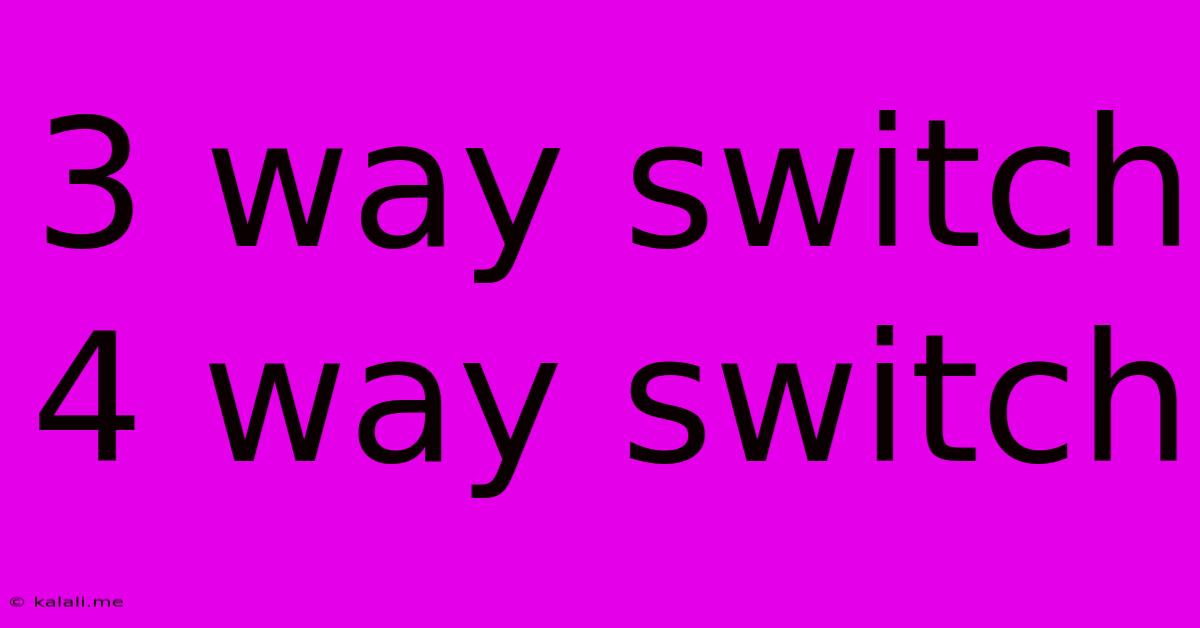3 Way Switch 4 Way Switch
Kalali
May 25, 2025 · 3 min read

Table of Contents
Understanding 3-Way and 4-Way Switches: Illuminating Your Wiring Choices
Controlling lights from multiple locations is a common home improvement project, and understanding the difference between 3-way and 4-way switches is crucial for success. This article will clarify the functionality of each switch type, explaining their applications and how they work together to provide versatile lighting control. We'll cover the basics of wiring and troubleshooting common issues, ensuring you have the knowledge to tackle your next electrical project with confidence.
What is a 3-Way Switch?
A 3-way switch, also known as a two-way switch in some regions, allows you to control a light fixture from two different locations. Imagine a hallway light: you can turn it on or off at either end. This convenience is achieved through a special internal wiring configuration that uses two common terminals and two traveler terminals. The traveler wires carry the power signal between the switches. This means that you need at least two 3-way switches for this functionality.
How a 3-Way Switch Works:
The key to a 3-way switch's functionality is the interaction between the two switches. When one switch is in the "on" position, it completes the circuit, allowing electricity to flow to the light. Changing the position of either switch alters the circuit, turning the light on or off. The traveler wires are the conduits for this power switching. It's important to note that both switches must be correctly wired, understanding that the ‘common’ terminals and ‘traveler’ terminals are distinct and play critical roles in the circuit's functionality.
What is a 4-Way Switch?
A 4-way switch expands lighting control beyond two locations. It allows you to add additional control points to an existing 3-way setup, effectively enabling the control of a light fixture from three or more locations. Unlike a 3-way switch, a 4-way switch doesn't directly connect to the power source; it acts as an intermediary, switching the signal between the traveler wires. You'll need at least two 3-way switches and one or more 4-way switches to achieve this multi-location control.
How a 4-Way Switch Works:
The 4-way switch works by intercepting the traveler wires coming from the 3-way switches. It has four terminals: two sets of common terminals which receive the incoming traveler wires and transmit them to the next switch in the chain. By switching the connection between these terminals, the 4-way switch alters the path of the power signal without directly controlling the power. This means that it needs to be positioned in the chain of switches, and not in the end positions like the 3-way switch.
Wiring Considerations and Common Problems:
Wiring 3-way and 4-way switches requires careful attention to detail. Incorrect wiring can result in malfunctioning lights or even electrical hazards. Consult reliable electrical diagrams before starting any wiring work and, if unsure, consider professional assistance. Common problems include:
- Incorrectly connected travelers: Double-check the wiring of the traveler wires to ensure they are correctly connected between the switches.
- Loose connections: Ensure all wire connections are secure and properly tightened.
- Faulty switches: A malfunctioning switch can disrupt the entire circuit.
Adding More Control Points:
Adding additional control points means adding more 4-way switches to your circuit. Each additional 4-way switch will require two incoming and two outgoing traveler wires, extending the control chain. Remember, the 3-way switches will always be positioned at either end of the circuit. The addition of a 4-way switch creates an additional control point in the circuit, enabling greater flexibility.
Conclusion:
Understanding the differences between 3-way and 4-way switches is key to successfully controlling lights from multiple locations. By correctly understanding their functionalities and wiring considerations, you can add convenience and flexibility to your home's lighting system. Remember safety is paramount when working with electrical systems; consult qualified professionals when in doubt.
Latest Posts
Latest Posts
-
Navy Sailor Getting Sucked Into A 6
May 25, 2025
-
20 Amp Outlet On A 15 Amp Circuit
May 25, 2025
-
Applications Of Complex Exponential Signals In Real Life
May 25, 2025
-
How To Clean Rust Stains From Clothes
May 25, 2025
-
Double Sink With Garbage Disposal Plumbing Diagram
May 25, 2025
Related Post
Thank you for visiting our website which covers about 3 Way Switch 4 Way Switch . We hope the information provided has been useful to you. Feel free to contact us if you have any questions or need further assistance. See you next time and don't miss to bookmark.